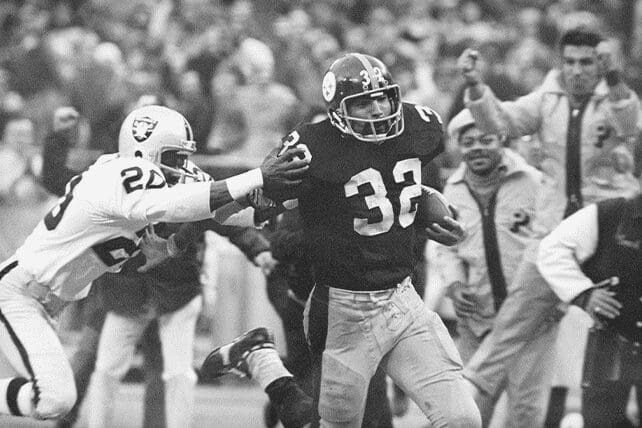PITTSBURGH (AP) — And it came to pass — actually, quarterback Terry Bradshaw came to pass, but bear with us. This is a story about football, culture and religion, so it seems right to begin with some biblical phrasing.
Thus, Bradshaw barely got off the pass, which was deflected in a collision between defender and receiver. Everyone thought the game was over except a hustling fullback, Franco Harris. He made an improbable shoestring catch and raced into the end zone, securing the Pittsburgh Steelers’ first-ever playoff win, the start of a long dynasty.
That was 50 years ago this Friday, on Dec. 23, 1972. But even though the NFL has officially designated it the greatest play in league history, it was bigger than that.
“Dec. 23 will henceforth be celebrated in Pittsburgh as the Feast of the Immaculate Reception,” legendary local sportscaster Myron Cope proclaimed.
He got the idea from a caller whose boyfriend had coined the name in a barroom victory celebration — putting a twist on the recently passed Catholic Feast of the Immaculate Conception, which marks the belief that the Virgin Mary was conceived without sin.
The coinage was as durable as it was instant, “using religious terminology to almost mythologize a sporting event,” said Anne Madarasz, chief historian and director of the Western Pennsylvania Sports Museum.
The Immaculate Reception crystallized the rise of the Steelers — even as their namesake industry was on the decline, as was the Pittsburgh of compact immigrant neighborhoods with multiple ethnic Catholic parishes.
By 1980, just as the Steelers were celebrating their fourth Super Bowl victory, Pittsburgh’s famed steel industry was moving from decline to all-out collapse. Many young people moved out of the demoralized region in search of jobs across the country (helping build the Steelers’ national fan base, by the way).
Still, those who left and those who stayed had the memory of a play called immaculate — a story with a never-give-up moral.
“This was our cultural rallying point,” said the Rev. Lou Vallone, a retired Catholic priest of the Diocese of Pittsburgh.
“It’s what kept us going as we saw our immigrant culture begin to dissipate, as the economics went down, the steel mills closed, as people moved out into the suburbs, people moved out of the area,” said Vallone. He used to preside at Masses at St. Peter Church, the parish nearest the stadium, where the congregants included many game-day tailgaters, clad in Steelers’ black and gold.
The city’s and region’s population decreased in the years after the catch. The ranks of Catholics — 40% of the region’s population in 1972 — dropped by about a third. Many ethnic and other parishes have closed or merged, and often merged again. A church named for the Immaculate Conception recently closed.

